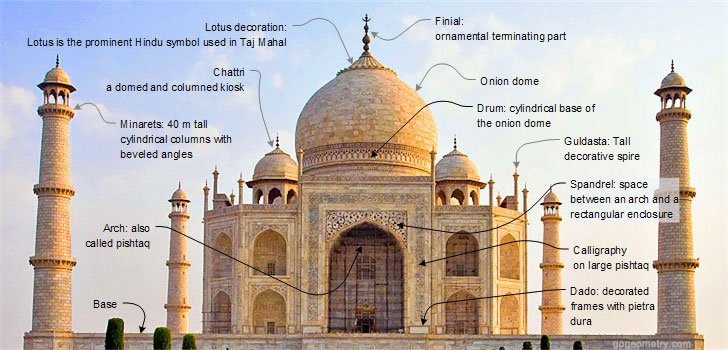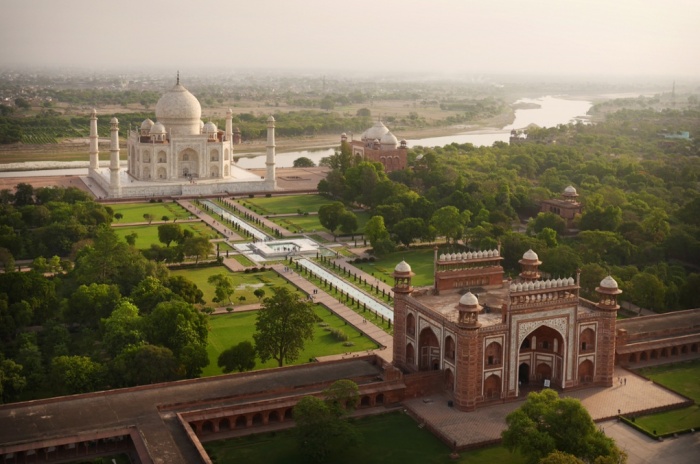Monday, 20 July 2015
Taj Mahal: The Taj Mahal from Persian and Arabic, "crown of palaces", pronounced may be a white marble sepulchre set on the southern bank of Yamuna stream within the Indian town of city. it had been commissioned in 1632 by the Mughal emperor Shah Jahan (reigned 1628–1658) to deal with the spot of his favorite partner of 3, Mumtaz Mahal.
Construction of the sepulchre was basically completed in 1643 however work continued on alternative phases of the project for a further 10 years. The Taj Mahal complicated is believed to possess been completed in its totality in 1653 at a value calculable at the time to be around thirty two million Indian rupees, that in 2015 would be valued at around fifty two.8 billion Indian rupees ($827 million US). the development project used around twenty,000 artisans beneath the steering of a board of architects diode by Ustad Ahmad Lahauri. The rounded marble spot associate degree element} of an integrated complicated consisting of gardens and 2 red-sandstone buildings encircled by a crenellated wall on 3 sides.
The Taj Mahal is regarded by several because the best example of Mughal design and is well known as "the jewel of Muslim art in India". it's one among the world’s most celebrated structures and a logo of India’s wealthy history. selected a UNESCO World Heritage website in 1983, the Taj Mahal attracts some three million guests a year
 In 1631, Shah Jahan, emperor throughout the Mughal empire's amount of greatest prosperity, was bereft once his favorite of 3 wives and beloved companion, Mumtaz Mahal, a Persian blue blood, died throughout the birth of their ordinal kid, Gauhara Muhammadan.Construction of the mausoleum began in 1632. The court chronicles of Shah Jahan's grief illustrate the romance historically command as an idea for mausoleum.The principal burial chamber was completed in 1643 and therefore the encompassing buildings and garden were finished regarding 5 years later
In 1631, Shah Jahan, emperor throughout the Mughal empire's amount of greatest prosperity, was bereft once his favorite of 3 wives and beloved companion, Mumtaz Mahal, a Persian blue blood, died throughout the birth of their ordinal kid, Gauhara Muhammadan.Construction of the mausoleum began in 1632. The court chronicles of Shah Jahan's grief illustrate the romance historically command as an idea for mausoleum.The principal burial chamber was completed in 1643 and therefore the encompassing buildings and garden were finished regarding 5 years later
The mausoleum incorporates and expands on style traditions of Persian and earlier Mughal design. Specific inspiration came from successful Timurid and Mughal buildings including; the Gur-e ruler (the place of Timur, root of the Mughal phratry, in Samarkand), Humayun's place, Itmad-Ud-Daulah's place (sometimes known as the Baby Taj), and crowned head Jahan's own Jama house of God in Delhi. whereas earlier Mughal buildings were primarily made of red arenaceous rock, Emperor promoted the utilization of white marble decorated with semi-precious stones. Buildings below his patronage reached new levels of refinement.
The advanced is ready around an oversized 300-metre (980 ft) sq. charbagh or Mughal garden. The garden uses raised pathways that divide every of the four quarters of the garden into sixteen sunken parterres or flowerbeds. Halfway between the place and entry within the center of the garden may be a raised marble tank with a reflective pool positioned on a north-south axis to replicate the image of the sepulcher. The raised marble tank is termed al Hawd al-Kawthar in relevancy the "Tank of Abundance" secure to Muhammad.
Elsewhere, the garden is arranged out with avenues of trees and fountains. The charbagh garden, a style impressed by Persian gardens, was introduced to Asian nation by Babur, the primary Mughal emperor. It symbolises the four flowing rivers of Jannah (Paradise) and reflects the Paradise garden derived from the Persian paridaeza, which means 'walled garden'. In mystic Islamic texts of the Mughal amount, Paradise is delineate as a perfect garden of abundance with four rivers flowing from a central spring or mountain, separating the garden into north, west, south and east.The main entree (darwaza) could be a monumental structure designed primarily of marble, and paying homage to the Mughal design of earlier emperors. Its archways mirror the form of the tomb's archways, and its pishtaq arches incorporate the script that decorates the topographic point. The rounded ceilings and walls have elaborate geometric styles like those found within the different arenaceous rock buildings within the advanced,
Most Mughal charbaghs square measure rectangular with a place or collapsible shelter within the center. The Taj Mahal garden is uncommon therein the most part, the tomb, is found at the tip of the garden. With the invention of Mahtab Bagh or "Moonlight Garden" on the opposite aspect of the Yamuna, the interpretation of the archeologic Survey of Asian nation is that the Yamuna watercourse itself was incorporated into the garden's style and
was meant to be seen jointly of the rivers of Paradise. Similarities in layout and field of study options with the Shalimar Gardens suggests each gardens could are designed by constant creator, Ali Mardan. Early accounts of the garden describe its copiousness of vegetation, as well as copious roses, daffodils, and fruit trees. because the Mughal Empire declined, the Taj Mahal and its gardens additionally declined. By the tip of the nineteenth century, country Empire controlled quite three-fifths of Asian nation, and assumed management of the Taj Mahal. They modified the landscaping to their feeling that additional closely resembled the formal lawns of London
was meant to be seen jointly of the rivers of Paradise. Similarities in layout and field of study options with the Shalimar Gardens suggests each gardens could are designed by constant creator, Ali Mardan. Early accounts of the garden describe its copiousness of vegetation, as well as copious roses, daffodils, and fruit trees. because the Mughal Empire declined, the Taj Mahal and its gardens additionally declined. By the tip of the nineteenth century, country Empire controlled quite three-fifths of Asian nation, and assumed management of the Taj Mahal. They modified the landscaping to their feeling that additional closely resembled the formal lawns of London
The Taj Mahal advanced is seagirt on 3 facets by crenellated red arenaceous rock walls; the side facing the stream is open. Outside the walls area unit many further mausoleums, as well as those of sovereign Jahan's different wives, and a bigger topographic point for Mumtaz's favorite servant.
At the so much finish of the advanced area unit 2 grand red arenaceous rock buildings that mirror one another, and face the edges of the topographic point. The backs of the buildings parallel the western and jap walls. The western building could be a place of worship and therefore the different is that the jawab (answer), thought to possess been made for study balance though it should are used as a house. Distinctions between the 2 buildings embody
the jawab's lack of a mihrab (a niche in a very mosque's wall facing Mecca), and its floors of geometric style whereas the ground of the place of worship is arranged with outlines of 569 prayer rugs in black marble. The mosque's basic style of a protracted hall head by 3 domes is analogous to others designed by Shah Jahan, significantly the Masjid-i Jahān-Numā, or Jama mosque, Delhi. The Mughal mosques of this era divide the sanctuary hall into 3 areas comprising a main sanctuary and slightly smaller sanctuaries on either facet. At the Taj Mahal, every sanctuary opens onto AN expansive vaulting dome. The far buildings were completed in 1643.
| Taj Mahal | |
|---|---|

Southern view of the Taj Mahal.
| |
| Location | Agra, Uttar Pradesh, India |
| Coordinates | 27°10′30″N78°02′31 |
| Height | 73 m (240 ft) |
| Built | 1632–1653[1] |
| Architect | Ustad Ahmad Lahauri |
| Architectural style(s) | Mughal architecture |
| Visitors | About 3 million (in 2003) |
| Type | Cultural |
| Criteria | (i) |
| Designated | 1983 (7th session) |
| Reference no. | 252 |
| State Party | India |
| Region | Asia-Pacific |







0 comments:
Post a Comment